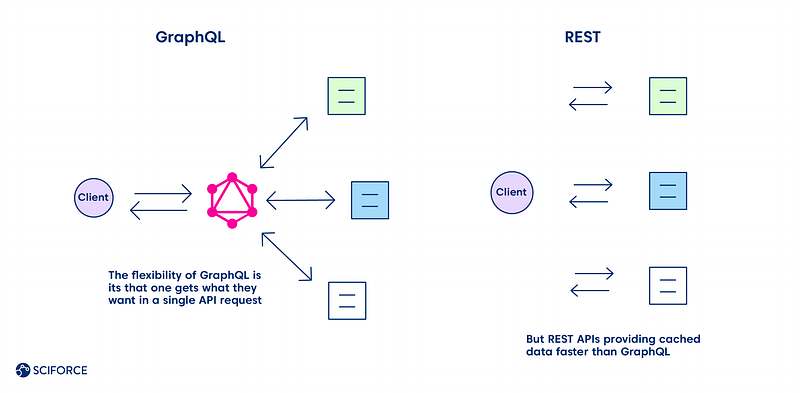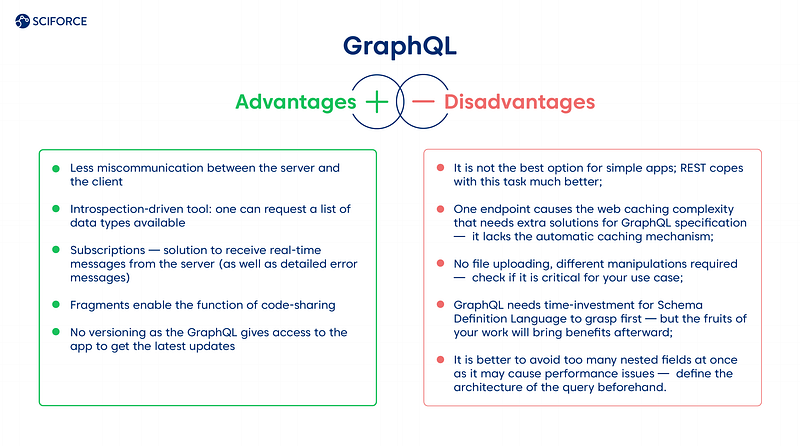Facebook developed GraphQL as a major problem-solver for more efficient mobile data loading in 2012 and released it as an open-source solution three years later. Since that time, it mistakenly associates with PHP only and lacks trust given Facebook’s reputation (if you know what I mean). However, a recent Netflix case that finds GraphQL as a game-changer to power the API layer and increase the scalability and operability of the studio ecosystem attracts attention. This specification already gained popularity — given State of JavaScript 2019 Report, 50.6% of respondents have heard of GraphQL and would like to learn it. However, The New York Times, Airbnb, Atlassian, Coursera, NBC, GitHub, Shopify, and Starbucks are already among the GraphQL users. We decided to dwell on the beauty, strength, and some constructions of GraphQL in its scalability, performance, and security aspects and tell about our use cases for a banking sphere and a platform of commercial targeting. See the list of useful toolkits added at the end as a bonus.
GraphQL is a convenient way of communication between a client and a server. Sometimes one can see it as an opponent to REST API given the main difference that GraphQL brings to the table — the only endpoint to fetch the data by one call from multiple sources. Meanwhile, we are to provide the space for consideration of whether this specification is relevant to particular tasks or whether REST API is the silver bullet for your case.
Both REST and GraphQL APIs are stateless, supported by any server-side language and any frontend framework, and exchange the data through the JSON. But the one and only endpoint containing the query expression to define the data that should be returned creates the what-you-see-is-what-you-get principle to optimize the work. Let’s deep dive into the specification’s main advantages and disadvantages.
The flexibility of GraphQL is its main advantage over REST, as one gets what they want in a single API request. Define the structure of the information to receive back, and it goes back in the format requested, no under-fetching or over-fetching.
Meanwhile, caching seems to be one of the GraphQL downsides compared to REST (see the complete list of all the pros and cons further). REST APIs use the HTTP caching mechanism, providing cached data faster. It leverages its community-powered and time-tested feature, leaving GraphQL behind at the moment.
Security is another area of improvement for GraphQL when comparing it with REST, which boasts a more mature system. The latter leverages HTTP authentication, JSON Web Tokens (JWT), or OAUth 2.0 mechanisms.

Unlike REST API, GraphQL has detailed documentation and supports the function of nested queries that contributes to the principle “no over fetching and under fetching data,” which happened while using the first specification. Query and mutation are the joint GraphQL operations. Thus, the CRUD (create, read, update, delete) model is not relevant for GraphQL as the create operation executes through the query command (other ones are implemented with mutations).
Advantages
Disadvantages

GraphQL provides developers with higher scalability of the system that applies in any sphere. We want to share our experience of function diversification for a commercial targeting platform and solving the banking application’s two-fold task.
The Platform for Commercial Targeting
GraphQL became a convenient solution for one of our clients who needed to develop a platform for commercial targeting, providing a straightforward approach for searching the potential customers in any national institution or facility. Using it, the client can direct the ads straight to the audience of interest using geolocation data and a set of filters. The platform consists of two primary services: one for geo-based consumer extraction based on PlaceIQ dataset usage and one for attribute-based (consumers identity graph) with consumer dataset. The project can be extended by adding the missing residential dataset to retrieve residents at the requested addresses. Also, the services could be wrapped into the REST API to provide the ability to trigger them using web requests.
Risk Reduction and Resilience Boosting Financial Platform
An average bank encounters no more than 100K transactions a day. Moreover, it also faces malicious actions and the risk of cyberattacks. One of our clients needed to empower their software platform to encounter higher transaction pressure and provide a higher risk-management system to avoid financial crimes. As a result, we have developed a solution that stands for the high amount of transactions and provides reports while detecting anomalies based on the transactions’ data in real-time.
Check out the growing GraphQL community to find the latest updates on this solution. There are many horizontally and vertically developed solutions for GraphQL client, GraphQL gateway, GraphQL server, and database-to-GraphQL servers. Add some of the tools that you enjoy using while working with GraphQL in the comments to this blog.
GraphQL’s servers are available for languages like JavaScript, Java, Python, Perl, Ruby, C#, Go, etc.
Apollo Server for JavaScript applications and GraphQL Ruby are some of the most popular choices.
Apollo Client, DataLoader, GraphQL Request, and Relay are among popular GraphQL clients. Graphiql, GraphQL IDE, and GraphQL Playground for IDE’s respectively.
Some handy tools:

and there are many more, depending on one’s needs, as lists keep growing. Mention in the comments tools that are worth it!